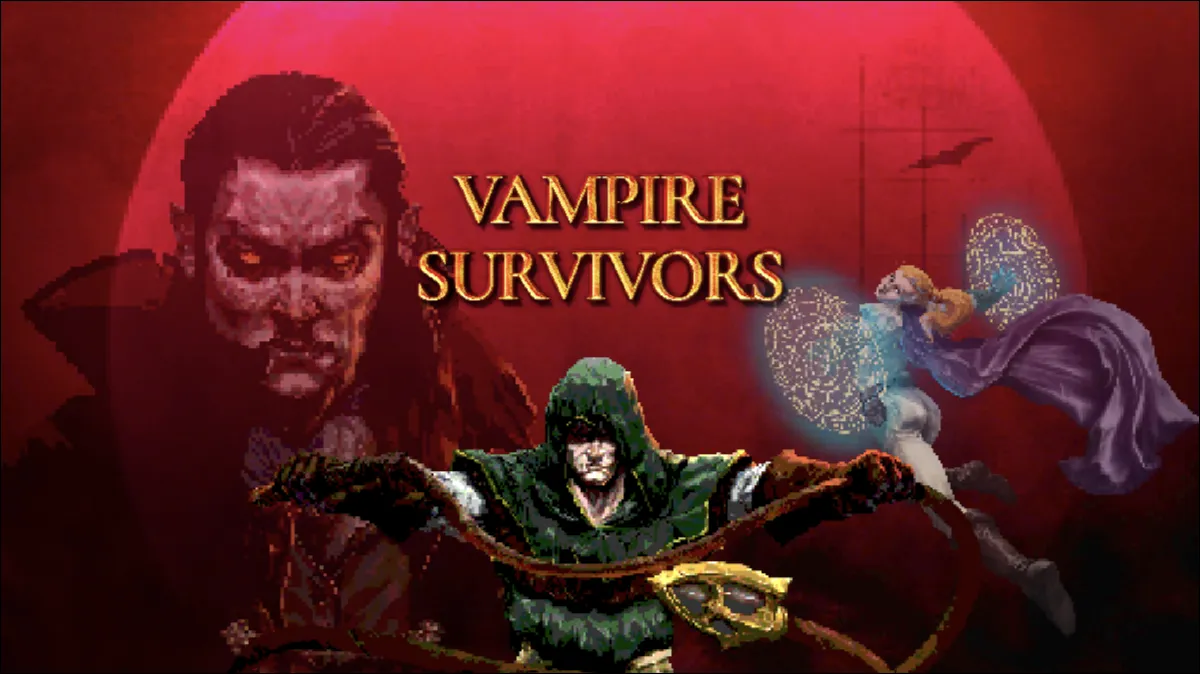Vampire Survivors: A Study of an Indie Phenomenon
Exploring and understanding the indie game that everyone’s talking about

Every so often, a tiny video game absolutely explodes and everyone has a theory to explain why. If you’re lucky, you might be privileged to see this growth happen in real-time. That kind of thing is a minor thrill for someone who writes about independently produced games.
So let’s talk about Vampire Survivors. Yes, that’s the actual name.
Vampire Survivors is a pretty low-key game, not all that different than a lot of what I’ve featured in other articles. I’d call it a twin-stick shooter, except the player can’t actually aim so it’s more of a single-stick shooter. You walk slowly around an arena, killing enemies to gain experience so that you can get random power-ups that allow you to fight slightly larger, stronger groups of enemies. The presentation is rough, the game looks and plays like something from an old Flash portal, and poncle, the developer, has minimal web presence.
And yet, as of this writing, Vampire Survivors has over 49,000 reviews on Steam, the vast majority of them positive. SteamDB shows an average player base of 25k-50k for February with a peak of 77,000 concurrent players, meaning that there have been periods where Vampire Survivors was in Steam’s top ten most-played games alongside titles such as Rust and Team Fortress 2.
Oh, and did I mention that the game is less than three months old?
So what’s the deal? Why did this one humble game grow to such massive size when others like it fell by the wayside? What induced Steam to put this game into my discovery queue, a dirty little feature that typically only feeds me AAA titles I don’t care about? Why is it that so many publications are writing long feature articles about this thing?
Let’s consider some of the factors at play, starting with an obvious one:

1. It’s very cheap
Vampire Survivors costs all of three dollars.
I know that I’ve said previously that low prices don’t necessarily correlate to bigger sales. I say things like that because research suggests it to be true: Games priced under five dollars don’t sell better than games at higher prices. But this may have more to do with the typical quality of ultra-budget games, as many of these titles are barely functional and thus not even worth their cut-rate price. On the other hand, if one has a product of respectable quality and wants to move a lot of units, it makes intuitive sense to price it low.
There are some very cheap people who lurk around on Steam — I’d know, being one of them. I’ve known people to pitch a fit because a game they really want to play is only 30% off. Yet even the cheapest among this group can part with the equivalent of a few bottles of Coca-Cola, especially for something that avoids the cash grab elements that make other pieces of budget software so unpleasant.
But for those people who do want assurances that they can get more enjoyment out of Vampire Survivors than a couple Snickers bars, the game has a very full-featured online demo that you can play right in your browser. It’s totally free and runs well even through my sometimes dodgy internet connection.
And the people who pay that tiny price might think they’re getting their money’s worth, because:

2. It has a lot of replay value
As I perused the Steam reviews, I noticed that people were putting quite a few hours of playtime on Vampire Survivors. A typical positive review comes with 15–30 hours, which is a lot for a game as simple as this. And while that may be a small sample, SteamDB backs it up, showing an estimated median playtime of around 12 hours.
By itself, this isn’t too surprising. Arcade-style games like Vampire Survivors have — in theory, at least — endless playtime. No one ever finishes a game like this. However, without the kind of goals found in modern titles, people often grow bored with such games and move on, revisiting them only sporadically. Vampire Survivors, on the other hand, has a lot of unlockable content, which gives the player a goal and a reason to keep coming back.
Offering twelve hours of content for three bucks is already a great deal, but the amount of content also has appeal to another group:
3. It’s content creator friendly
My initial assumption was that some major online figure had shown off Vampire Survivors and this was what launched it. While a few popular streamers have featured the game, this isn’t quite true. Rather, this looks to be a case of everyone wanting to show it off.
SteamDB shows that Vampire Survivors was already getting Twitch views within the first few weeks of its launch, eventually peaking at almost 140,000 viewers late in January. As far as I can tell, this ran the gamut from the big-time to the upstarts. A lot of people were making content about this game.
There’s a certain logic to this. Vampire Survivors is an action-focused game meant for short bursts of play, with lots of content and a fair amount of randomness between runs. It’s exactly the kind of game that one could play for hours on end, record and chop up, and discuss later. Add to that the low price point and the fact that most systems are going to be able to run the game and OBS at the same time, and it makes for a great entry point as well.
And so the legend of Vampire Survivors spread, with deep-dive articles appearing throughout February as it worked its way into the mainstream. And I suspect it has more room to grow, because of another factor:
4. It’s accessible to a wide audience
Speculation time: I think very simple games such as Vampire Survivors are going to have a moment in the not-too-distant future. That’s not to say that they’re all going to break out of the atmosphere like this one, but I do think that the demand for titles like this will increase. And a large part of this will be due to the Steam Deck and its inevitable competition.
I’m basing a lot of this on the kind of games that have been doing well on the Nintendo Switch, and more generally on what kind of games have always succeeded on portable systems. One gets a state-of-the-art console to play state-of-the-art games — a consumer might noodle about with some indie darling on his PS5, but that’s not why he bought it. Simpler, old-school games find smaller systems to be a friendlier place, at least on a psychological level. I believe that portable gaming PCs are going to open up the market even more widely for these games as well.
Of course, the Steam Deck isn’t what’s driving the current success of Vampire Survivors, but the simplicity of the game is probably having an impact all the same. There’s no intimidating professional scene or densely layered online community one must contend with for a game like this, you can simply pick it up and play it.
This brings me to the last, most important factor:
5. It’s fun
Some of what I’ve said above might lead you to think that Vampire Survivors is a bad game. It’s not. And while it might be easier to praise if it had a less silly name, the bottom line is that Vampire Survivors is fun to play.
It’s amazing how seldom the term “fun” appears in the modern gaming press. It feels like we’re supposed to be too sophisticated for terms like that. We’re supposed to talk about aesthetics and mechanical complexity and rich characterization. This is exactly what I see as I read through some of the recent articles on Vampire Survivors — people pulling this simple little game apart in hopes of finding some high-minded justification for liking it.
But no one needs a justification for enjoying a particular video game, even one that might strike you as unacceptably casual. You can just think it’s fun. Say it out loud: Fun. See? Not scary.

If I’m being totally honest, even the above is a lot of smoke and mirrors. Oh, it’s all true, and I absolutely stand by it — Vampire Survivors is a cheap game with easy-to-understand gameplay that a streamer can easily drop into his rotation, and all of that is contributing to its success. The problem is that there are many games on Steam that fit that bill — I’d know, I own a lot of them. Any justification as to why this game has nearly fifty thousand reviews while many similar titles with similar quality have fewer than a hundred is bound to involve a lot of post facto rationalization and motivated reasoning.
The honest explanation for the success of Vampire Survivors may be down to serendipity. This was just the one game of many that got noticed, and the nature of our media environment is that once something gets a little bit of popularity, it tends to get a lot of popularity. Everything I’ve described in this article is necessary but not sufficient…or is it even all that necessary? After all, social media activity and engagement with fans are also supposed to be necessary, and as far as I can see the developer hasn’t done too much of that.
So maybe I should take some of my own advice and not sweat it too much. There isn’t a lot to say about Vampire Survivors, but it’s a fun little game and it costs very little, and maybe we should all just go play it for while.
